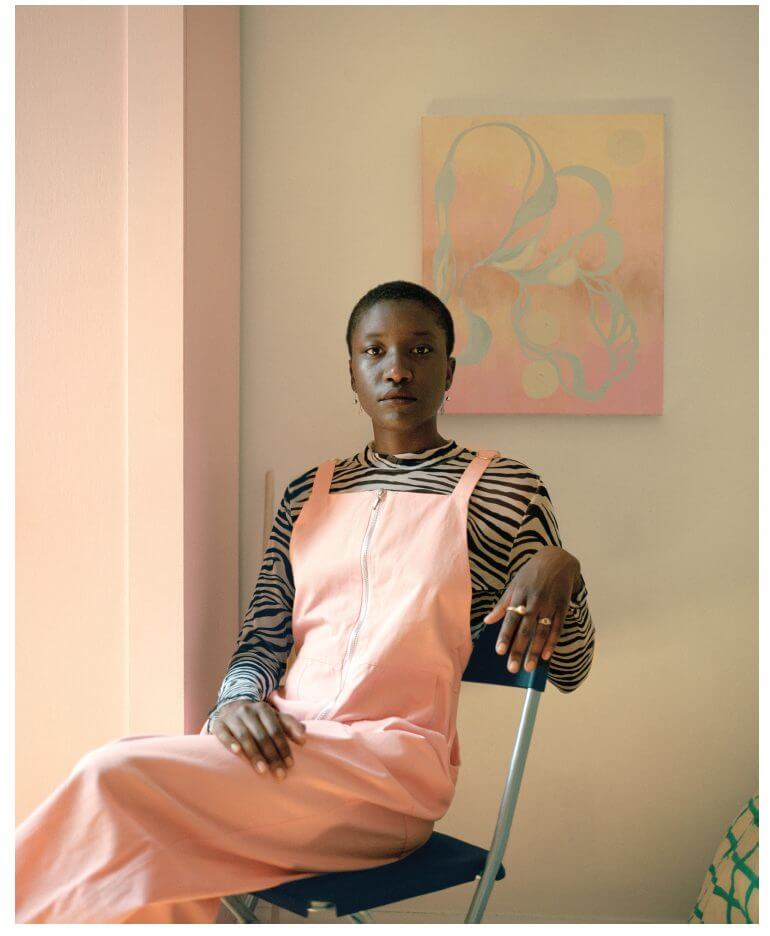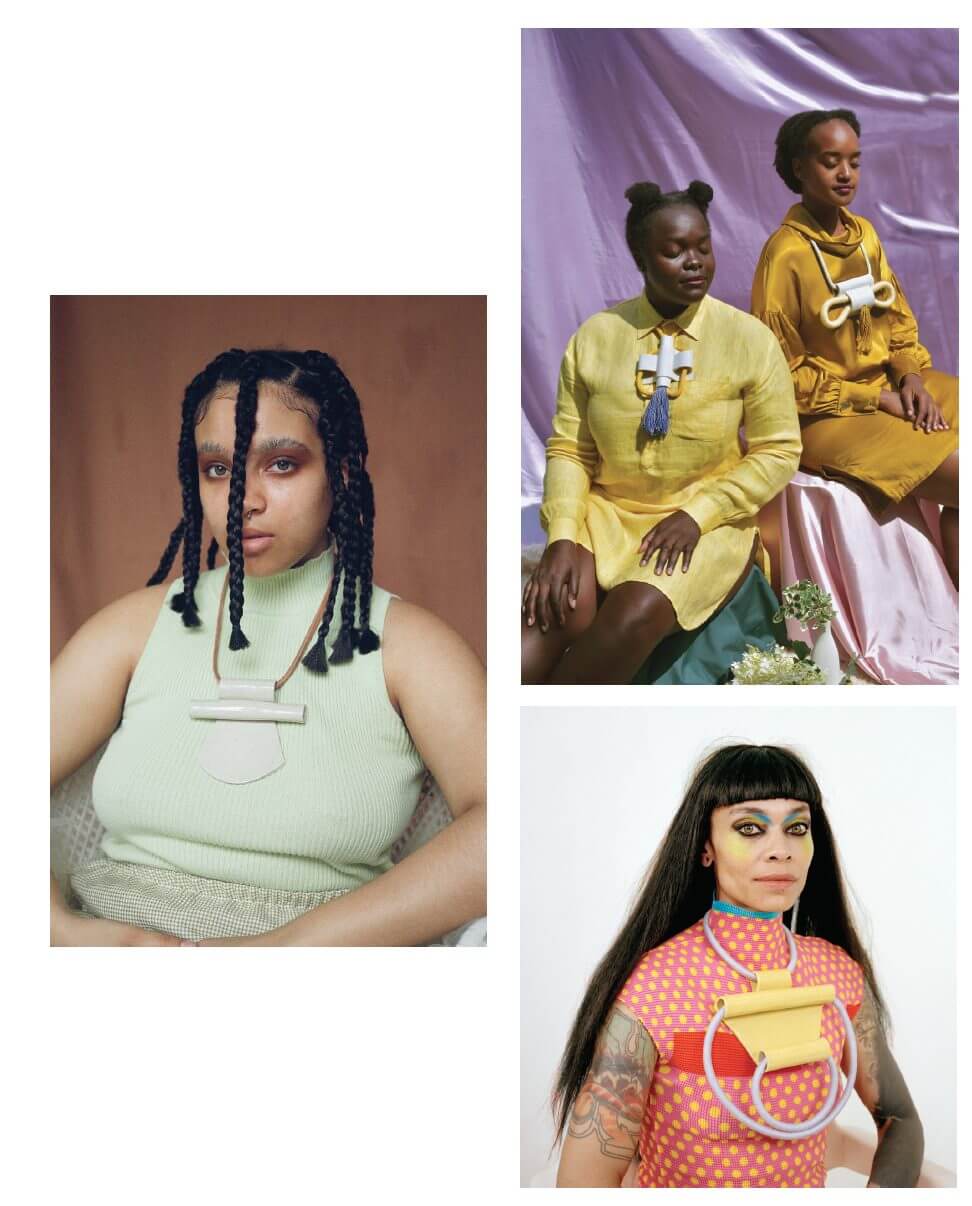Black art matters
Spotlight on Shaya Ishaq
Francesca Ekwuyasi

Photo by Brandon Brookbank
Shaya Ishaq’s work moves fluidly between mediums—words, ceramics, fibres, jewellery—while maintaining a central locus of honouring Black lineages and sparking light toward liberated Black futures. Tenacious and ever-evolving, Ishaq walked away from journalism school and signed up for a hand-building course at a pottery studio in her hometown of Ottawa. “I really fell in love that winter,” she says. “It was pretty magical to come into the studio first thing in the morning to see my work come out of the kiln or even just how the clay would change when the pieces would air dry before firing. I was totally enraptured by the many stages of the medium of clay.”
Now, Ishaq masterfully combines ceramics and fibres to create ornate and intricate wearable art pieces. On the origin stories of these designs, she says, “At their core, [these materials] come from the earth (before mass production and industrialization, before creating synthetic versions) and I am very dedicated to working with them to see what connections arise. Both invite a meditative process that has saved me time and again.” She started bridging relationships between ceramics and textiles when she began art school in Halifax, going on to continue her studies in Montreal. “It’s only been in recent years that some kind of visual vocabulary has emerged.”
Ishaq’s wearable art possesses a distinct aesthetic that plays with the juxtaposition of hardness and softness, gloss and matte, the whimsy of tassels and sharp curves of ceramic. That aesthetic is visible in her Holy Wata collection, showcased on her online portfolio, and her most recent solo show Mirror Mirror, exhibited at the Anne Dahl Concept Studio in Ottawa.
“Some of my stylistic choices are definitely informed by Black and Afro-diasporic futurist and Indigenous aesthetics,” she says. “More and more, I am trying to find inspiration from my own cultural background in East Africa … which requires a lot of digging, but is ultimately worth it because it brings me closer to myself in a way, by allowing me to reconnect with an embodied sense of self.” Ishaq is also inspired by people who express a certain kind of “unfuckwithable energy,” including characters like Lauren Olamina from Octavia E. Butler’sParable series or Ketara from Avatar, and performers like
Moor Mother, Debby Friday, Backxwash, and Kelsey Lu.
Themes of Blackness in regards to identity, craft, culture, and liberation are integrally woven into Ishaq’s spatial design, as well. During a month-long residency at Halifax’s Khyber Centre for the Arts, she created Black Libraries Matter, for which she reimagined the gallery space by creating a Black library by inviting community members to donate books by Black authors.
Soon after, she had a collaborative exhibit, Reconcile/Overcome, at the Ottawa Art Gallery. It consisted of a handwoven sculptural textile piece and written work reflecting on the consequences of the transatlantic slave trade and labour of enslaved Black people on the foundation of Canada and the United States. Her written work from the exhibit includes this excerpt: “Made by my Black hands in celebration of Black spiritual resilience in all corners of the world. Not all our struggles are alike yet we are gold. We are nuanced and yet are gold. We are resilient and we are gold.”
In reflecting on the intersections of Blackness, fashion, beauty, and culture, Ishaq understands that Blackness and popular material culture are also deeply entwined. “I believe this includes Afro-diasporic cultural production as well. I really believe that materiality is political and omnipresent.” Black culture, she says, “is celebrated yet the people who create it are oftentimes disregarded, treated as disposable, only celebrated when they are dead or in moments like this where the world has to recognize the deep systemic patterns at play. There are so many case studies of appropriation that intersect Blackness, fashion, and beauty.”
In its variety of mediums, Ishaq’s practice seeks to centre Blackness and move closer toward creative sovereignty, despite continued appropriation of Black art and culture. “Ultimately, the more we are able to lean into our own creative sovereignty, the more authentic our creations can be. That sovereignty can look like not fighting for ‘a seat at the table,’ detaching ourselves from Eurocentric symbols of success but really doing things for us and by us.”

TOP: Photo by Cheryl Hann; Models: Francesca Ekwuyasi and Portia Karegeya LEFT: Photo by Mallory Lowe; Model: Jada BOTTOM: Photo by Brandon Brookbank; Model: Candy Contrera